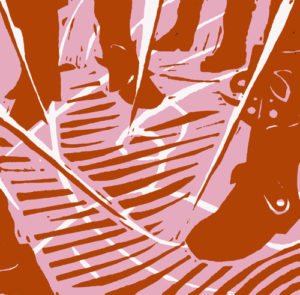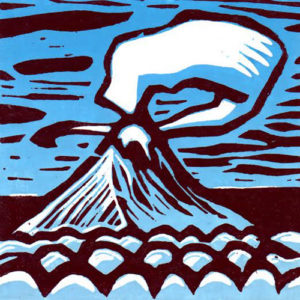This week we are thrilled to feature Drusilla Cole – printmaker and author of several books.
Could you tell us a little about yourself?
I consider myself to be a printmaker, I occasionally teach workshops and am author of several books on Surface Pattern (see below).
I love the technique and process of printmaking, especially reduction linocuts, and I also love to experiment with creating woodcuts, collagraphs and etchings.
Colour is very important to me as my artwork demonstrates. My main interest is in art ceramics, quirky flea market finds or unusual architectural constructions.

Describe your process.
I work from my own photographs and drawings and quite often plunge in, cutting and proofing and making decisions as I go along. I love the challenge of
finding solutions to the issues that arise as I work
How and where did you learn to print?
I learnt screen printing when I attended Central School of Art many years ago, and continued with screen printing in my career as Senior Lecturer teaching
on the BA (Hons.) Surface Design course at the University of the Arts, London for over 25 years.
When I took early retirement I decided to learn linocutting and read books and practised and printed until I got the hang of it. I enjoy learning new skills
and regularly take classes in other printmaking techniques too.

Why printing?
Flat colour has always appealed to me and I love the challenging combination of technique, colour, instinct and artistry. The end result is often, to my
eye, very pleasing.
Where do you work?
In a large light and airy room in my house in Bishops Castle, overlooking the old market square and rooftops to the hills beyond.

Describe a typical day in your studio.
If I have project in mind I might be sitting at my table by the window cutting a lino using my Pfeil tools, whilst listening to the radio. Or I might be
proofing and printing. Sometimes I might have to spend time cutting a mount and framing a picture ready to hang. I draw quite a lot , especially in
the evenings and these inform my work too.
How long have you been printmaking?
I started screen printing when I was 17, but only started linocutting 8 years ago

What inspires you?
Often, my artwork demonstrates my fascination with quirky and unusual architectural constructions, especially any containing lettering. Another fascination
is with vintage ceramics, particularly those made in the1960s.
What is your favourite printmaking product?
My Rollaco press which I bought last year on EBay . My Ternes Burton pins are pretty amazing too – they have really helped to resolve registration issues.

What have you made that you are most proud of?
I particularly enjoyed creating my ‘Godzilla’ print. I used caustic soda for the sky and later the foreground, and I cut and employed various
paper masks plus I continued to make additional reductions. It was very satisfying

Where can we see your work? Where do you sell?
I have a website www.drusillacole.co.uk
I am on Facebook as Drusilla Cole Printmaker.
I am on Instagram.com as Drusilla Cole
I sell through Artfinder.com and Print Solo.com
My work is in various galleries in the UK, notably The Mere Gallery, Windermere and the Ironbridge Fine Arts & Framing Gallery.
Publications
‘1000 Patterns’ London, A & C Black, 2003
‘Patterns – New Surface Design’ London, Laurence King 2007, reprinted in a mini book form 2012
‘Textiles Now’ London, Laurence King, 2008
‘The Pattern Sourcebook – A century of surface design’ London, Laurence King, 2009, reprinted in mini form, 2015

What will we be seeing from you next?
I’m currently exploring combining wood engraving with linocuts!
Do you have any advice for other printmakers and creatives?
Keep going. Keep looking at other artist’s work and exploring different methods and techniques.
And join a group online such as Linocut Friends Group on Facebook . The access to large numbers of people worldwide is amazing – they are so often full
of help and advice and share examples of work from all styles and abilities
.







































































































